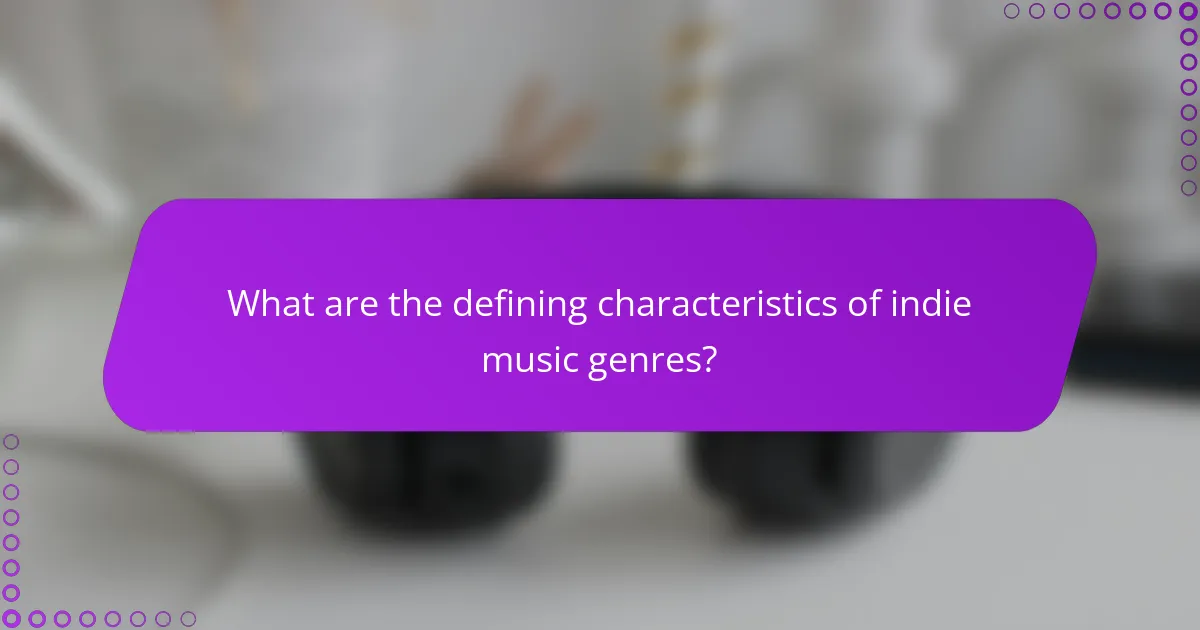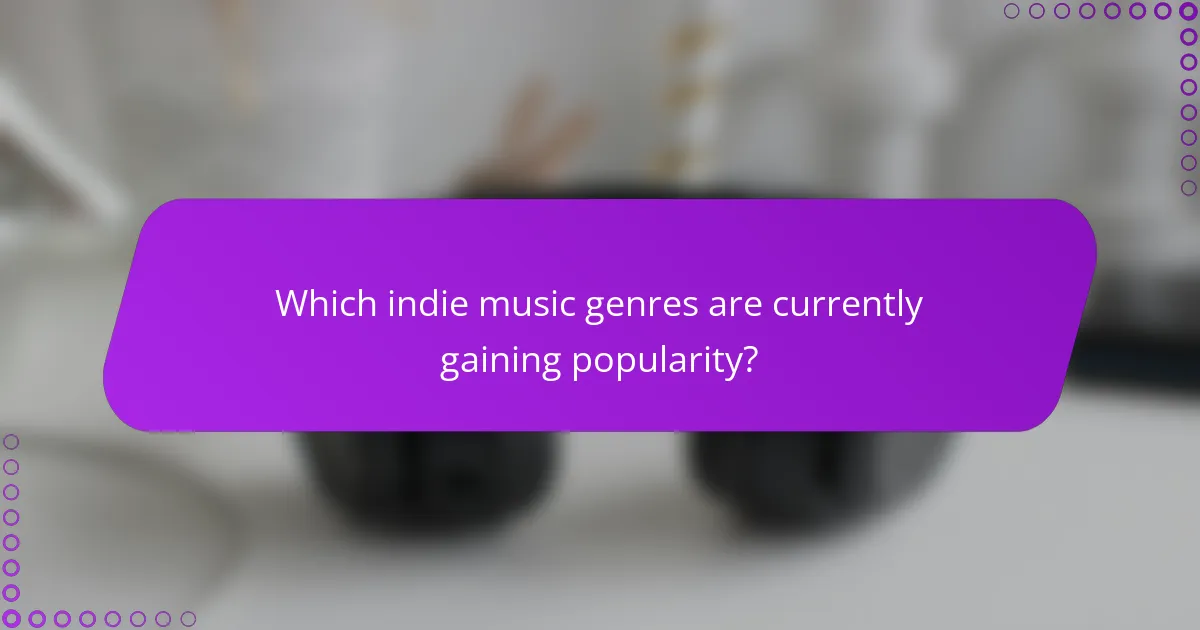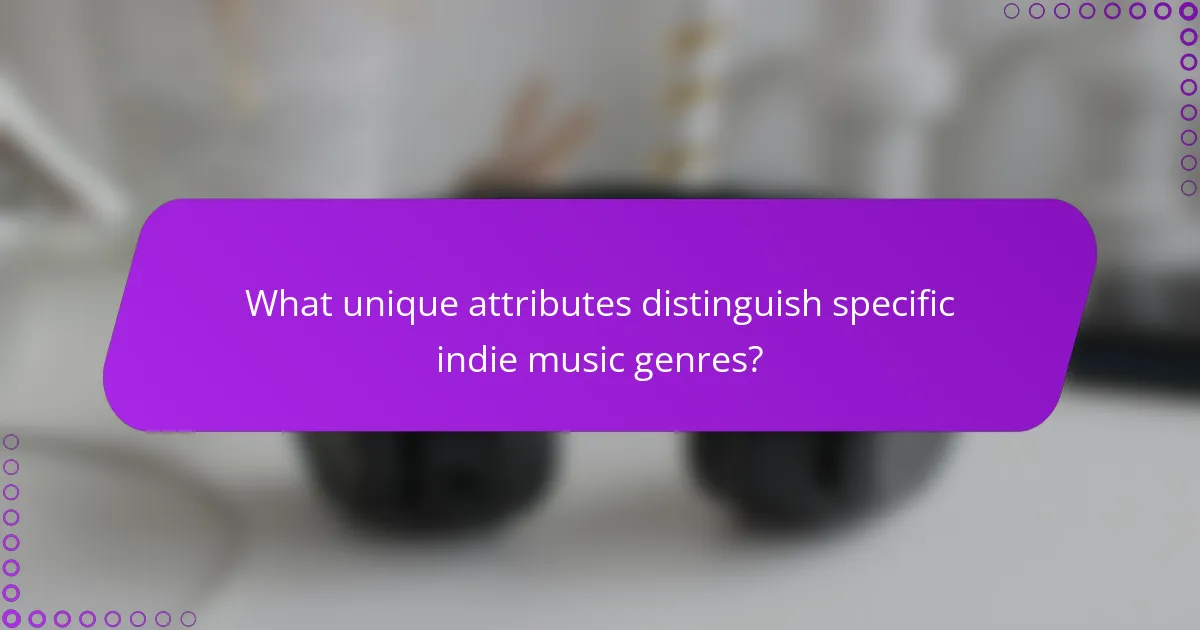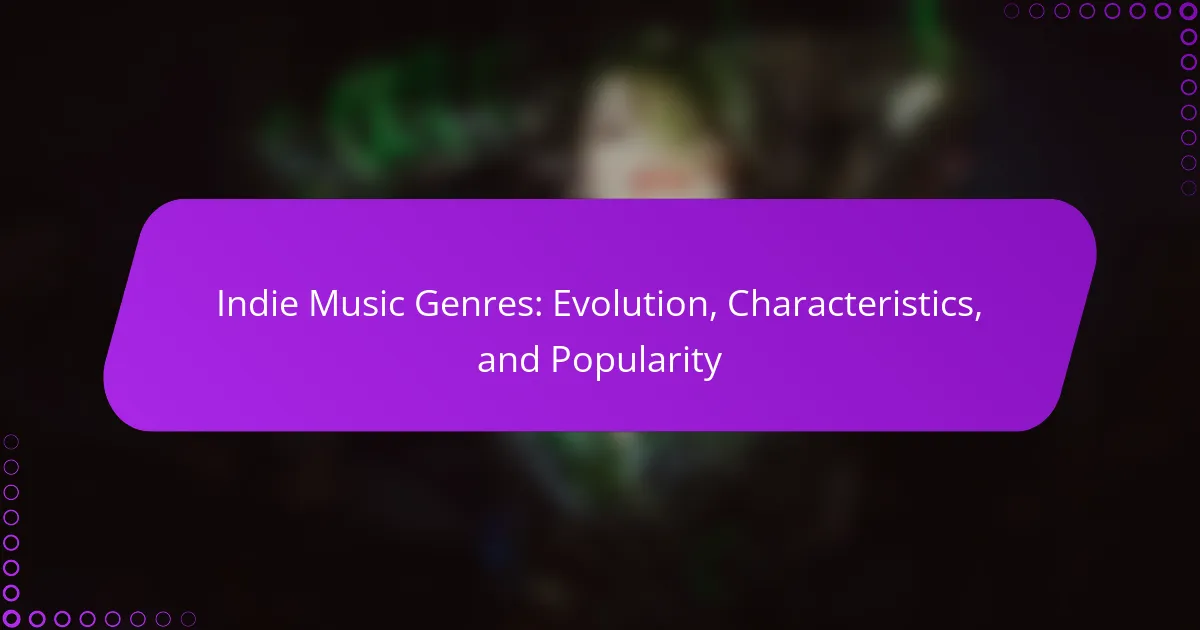Indie music genres have transformed significantly since the 1980s, driven by cultural changes and technological advances. This article explores the characteristics of indie music, its evolution into diverse subgenres, and the factors contributing to its growing popularity. Key genres like bedroom pop and lo-fi are highlighted, showcasing their unique soundscapes and appeal to younger audiences. Additionally, the challenges indie musicians face in today’s digital landscape are examined.

How have indie music genres evolved over the decades?
Indie music genres have evolved significantly since the 1980s, reflecting cultural shifts and technological advancements. Initially characterized by a DIY ethos, indie music diversified into various subgenres, including indie rock, folk, and electronic. The rise of the internet in the 2000s facilitated access to music distribution, allowing indie artists to reach wider audiences. As a result, genres like lo-fi and bedroom pop gained popularity, showcasing unique soundscapes and personal storytelling. Today, indie music continues to thrive, blending influences from mainstream genres while maintaining its distinct identity.
What key cultural movements influenced indie music?
Indie music has been significantly influenced by various cultural movements, including punk, DIY ethics, and alternative rock. The punk movement of the 1970s emphasized independence and authenticity, laying the groundwork for indie music’s ethos. DIY culture promoted self-production and distribution, allowing artists to maintain creative control. Additionally, the alternative rock scene of the 1990s expanded indie’s reach, blending genres and appealing to a broader audience. These movements collectively shaped indie music’s evolution, characteristics, and popularity.
Which technological advancements shaped the indie music landscape?
Technological advancements have significantly transformed the indie music landscape. Digital distribution platforms like Bandcamp and SoundCloud have empowered artists to share their music directly with audiences, bypassing traditional gatekeepers. Additionally, social media has facilitated grassroots marketing, allowing indie musicians to build fan bases organically. Home recording technology has lowered production costs, enabling more artists to create high-quality music independently. Streaming services have altered consumption patterns, increasing accessibility and reach for indie genres. Overall, these innovations have fostered a diverse and vibrant indie music scene.

What are the defining characteristics of indie music genres?
Indie music genres are characterized by their independence from major record labels, diverse soundscapes, and emphasis on artistic expression. Key features include a DIY ethos, genre-blending, and a focus on lyrical depth. The evolution of indie music reflects a shift towards more personal and experimental styles, appealing to niche audiences. Popularity has surged with digital platforms, allowing artists to reach global listeners without traditional industry constraints.
How do indie music genres differ from mainstream genres?
Indie music genres differ from mainstream genres primarily in their approach to creativity and production. Indie music often emphasizes artistic expression, experimentation, and authenticity, whereas mainstream genres focus on commercial viability and mass appeal. Indie artists frequently operate outside major label systems, allowing for greater creative freedom. This independence fosters unique sounds and diverse influences, setting them apart from the more formulaic structures often seen in mainstream music. As a result, indie music can reflect niche cultural movements and resonate deeply with specific audiences, contributing to its growing popularity.
What role does DIY culture play in indie music?
DIY culture significantly empowers indie music by promoting creative freedom and grassroots movements. This culture encourages artists to produce, distribute, and market their music independently. As a result, musicians can explore diverse genres without commercial pressures. The unique attribute of DIY culture is its emphasis on authenticity, allowing artists to connect directly with their audience. This fosters a sense of community and collaboration, enhancing the popularity of indie music in various forms.

Which indie music genres are currently gaining popularity?
Indie music genres currently gaining popularity include bedroom pop, lo-fi, and synthwave. These genres are characterized by their DIY production styles and unique soundscapes. Bedroom pop, for example, emphasizes intimate vocals and relatable lyrics, appealing to younger audiences. Lo-fi blends nostalgic samples with modern beats, creating a chill atmosphere. Synthwave revives 1980s electronic music, attracting fans of retro aesthetics. Each genre showcases the evolving landscape of indie music, reflecting diverse influences and innovative artistry.
What trends are emerging in the indie music scene?
Emerging trends in the indie music scene include increased genre blending, digital distribution growth, and a focus on social issues. Artists explore diverse sounds, integrating elements from various genres, which broadens their appeal. The rise of streaming platforms enhances accessibility, allowing independent artists to reach wider audiences. Additionally, many indie musicians use their platforms to address social and political issues, reflecting a commitment to activism and community engagement.
How do regional sounds influence indie music popularity?
Regional sounds significantly enhance indie music popularity by creating distinct identities and fostering local connections. Unique musical elements, such as traditional instruments or regional dialects, resonate with listeners and attract niche audiences. For instance, the incorporation of folk sounds from specific areas can lead to a loyal fan base that appreciates authenticity. Additionally, local music scenes often promote collaboration among artists, further enriching the genre’s diversity and appeal. As a result, regional influences play a crucial role in shaping the evolution and success of indie music.

What unique attributes distinguish specific indie music genres?
Indie music genres are distinguished by their unique characteristics, such as stylistic diversity and independent production. Each genre, like indie rock or synth-pop, showcases distinct sounds and cultural influences. For instance, lo-fi indie often features raw production and personal themes, while indie folk emphasizes acoustic instrumentation and storytelling. Additionally, the evolution of these genres reflects broader societal trends, with sub-genres emerging from grassroots movements and digital platforms. This rich tapestry of attributes contributes to the ongoing popularity and evolution of indie music.
Which indie genres are known for their lyrical themes?
Indie genres often explore deep and personal lyrical themes. Genres like indie folk focus on storytelling, emotions, and introspection. Indie rock frequently addresses social issues and personal experiences. Additionally, genres such as dream pop emphasize surreal and ethereal imagery, while lo-fi often reflects on nostalgia and everyday life. These thematic explorations contribute to the unique identity of each genre within the indie music landscape.
How do instrumentation and production styles vary across indie genres?
Instrumentation and production styles vary widely across indie genres, reflecting diverse artistic expressions. Genres like indie rock often feature live instrumentation, emphasizing guitars and drums, while synth-pop incorporates electronic elements and layered vocals. Folk-influenced indie uses acoustic instruments, creating an intimate sound. Production techniques range from lo-fi aesthetics in bedroom pop to polished finishes in indie pop, showcasing unique attributes of each genre. As a result, these variations contribute to the rich tapestry of indie music, influencing listener preferences and genre popularity.

What are the challenges faced by indie musicians today?
Indie musicians today face significant challenges that impact their careers and creative expression. The primary issues include financial instability, limited access to distribution channels, and the overwhelming competition in the digital landscape.
Financial instability arises from the lack of traditional funding sources, as many indie artists rely on streaming revenues, which are often minimal. Limited access to distribution channels means that getting music heard can be difficult without partnerships with larger labels or platforms. Overwhelming competition exacerbates these issues, as countless artists vie for attention online, making it challenging for indie musicians to stand out.
Additionally, the evolving nature of music consumption, driven by technology and social media, requires artists to continually adapt their marketing strategies. They must engage with audiences directly, which can be time-consuming and detract from their creative processes. The need to balance artistry with business acumen presents a unique challenge for indie musicians today.
How do indie artists navigate distribution and promotion?
Indie artists navigate distribution and promotion through digital platforms and social media. They often utilize services like DistroKid and TuneCore for music distribution. Promotion strategies include engaging with fans on platforms like Instagram and TikTok, leveraging their unique sound to build a loyal following. Collaborations with other artists enhance visibility and expand reach. Additionally, indie artists frequently participate in live performances and local events to connect directly with audiences. This grassroots approach fosters community support and drives organic growth.
What impact do streaming platforms have on indie music success?
Streaming platforms significantly enhance indie music success by providing greater accessibility and exposure. They allow independent artists to reach wider audiences without traditional barriers. Platforms like Spotify and Apple Music offer curated playlists, which can boost visibility and listener engagement. Additionally, data analytics from these platforms help artists understand their audience better, enabling targeted marketing strategies. The democratization of music distribution through streaming has transformed the indie music landscape, fostering diverse genres and styles.

What are the best practices for discovering new indie music?
To discover new indie music effectively, explore diverse platforms and communities. Utilize music streaming services that feature curated indie playlists. Follow social media accounts of indie artists and labels for updates. Attend local music events and festivals to experience live performances. Engage with online forums and blogs dedicated to indie music for recommendations.
Which platforms are most effective for indie music exploration?
Streaming services like Spotify and Apple Music are most effective for indie music exploration. These platforms offer extensive libraries, curated playlists, and personalized recommendations. Social media platforms like Instagram and TikTok also play a significant role by allowing artists to share music directly with audiences. Additionally, Bandcamp fosters direct artist support and discovery through user-generated content and community engagement. Each platform enhances the indie music experience by connecting listeners with diverse genres and emerging artists.
How can fans support indie artists effectively?
Fans can support indie artists effectively by engaging with their music and promoting their work. Active listening on streaming platforms boosts artists’ visibility. Sharing music on social media amplifies reach, while attending live shows strengthens community ties. Purchasing merchandise directly supports artists financially. Additionally, fans can contribute by leaving positive reviews and participating in crowdfunding campaigns, which provide crucial resources for indie projects.
What common mistakes should indie artists avoid?
Indie artists should avoid common mistakes that hinder their growth and success. Failing to define a unique sound can make it hard to stand out in diverse indie music genres. Neglecting to build a strong online presence limits audience reach. Overlooking the importance of networking can restrict collaboration opportunities. Additionally, mismanaging finances can lead to unsustainable practices. Finally, disregarding feedback can stifle artistic evolution.
